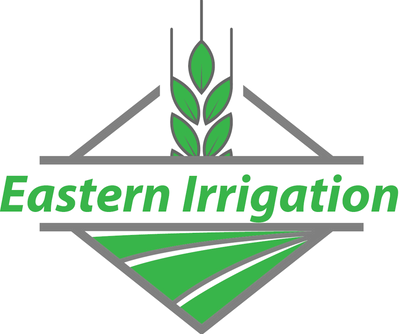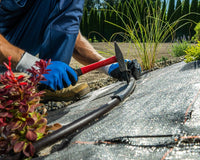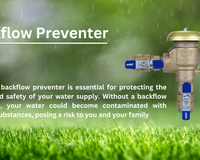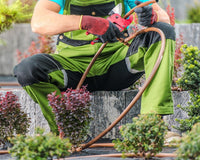For those involved in landscape maintenance, understanding irrigation system components is crucial. This guide provides insights into frequently discussed Drip Information: irrigation parts, their uses, and valuable tips for optimal performance.
Embracing Micro-Tubing
Micro-tubing, a vital part of drip irrigation systems, comes in two main sizes: 1/8” and 1/4". The smaller size is specifically designed for use with 12 outlet drip heads and spray sticks. The 1/4" variant is available in either vinyl or polyethylene, with the latter being more temperature resistant but less flexible.

Using micro-tubing is straightforward - its primary function is to extend the reach of a dripper or micro-sprinkler from the main half-inch poly tubing. This makes it ideal for watering plants in pots or containers. A hot tip: soften the tubing ends with warm sunlight or hot water for easier insertion of barbs.
* 1⁄4” micro-tubing is available in Vinyl or Polyethylene
* 1⁄4” Poly is less bendable than vinyl but withstands high temperatures better than vinyl
* Micro-tubing is primarily used to extend a dripper or micro-sprinkler away from the 1⁄2” poly tubing or to branch off to reach plants in containers
* Both 1⁄4” vinyl and poly accept 1⁄4” barbed fittings
* Uncoil the tubing and lay it out in direct sunlight or soak the end in a cup of hot tap water to make it easier to insert barbs
Understanding Drippers
The role of a dripper in irrigation is pivotal. There are two types: pressure compensating (PC) and non-pressure compensating.
PC drippers are preset to a particular flow rate and are perfect for drip systems that need to navigate elevation changes or cover long distances (over 250 feet). Their main advantage? They adjust for pressure variations throughout the system, giving you a more uniform watering experience.

On the other hand, non-PC drippers are best suited for level residential systems less than 250 feet long. Key point: never use PC drippers for gravity flow or rain barrel systems; make sure they operate at pressures between 10 and 45 psi.
* Are categorized into two types- pressure compensating, and non-pressure compensating
* Pressure compensating (PC) drippers are pre-set at a specified flow rate and are non-adjustable
* PC drippers are preferable for drip systems with significant changes in elevations and/or long run lengths (over 250’).
* PC drippers compensate for differences in pressure throughout the system and can provide better system uniformity
* Non- PC drippers are suitable for most residential drip systems that are under 250 feet in length and are relatively level.
* PC drippers should not be selected for use with gravity flow or rain barrel systems.
* PC drippers must be operated at pressures between 10 & 45 psi.
* Non -PC drippers include flag drippers, button drippers, in-line drippers, adjustable drippers
* Select the drippers flow rate based on the soil type, not the plant type or size
* Use lower flow drippers for denser soils high in clay content
* PC drippers cannot be taken apart for cleaning.
The Magic of Driplines
Driplines, a kind of soaker hose, hydrate the soil near the tubing. They're great for saturating raised vegetable beds, encouraging deep tree watering, or for "square foot" gardening. Remember to choose emitter spacing based on soil type - go for shorter spacing for sandy soils.

* Is a type of soaker hose that saturates the soil adjacent to the tubing
* Can be laid on the soil surface and/or covered with mulch
* Available in two diameters, 1⁄4” or 1⁄2”
* 1⁄4” is non-PC, 1⁄2” is pressure compensating
* Emitters are “built- in” to the tubing wall at pre-set spacings
* Excellent choice for raised vegetable beds, square foot gardening, deep watering of trees
* Determine emitter spacing distance based on soil type-use shorter spacing for sandy, lighter soils
Exploring Micro-Sprinklers, Spray Jets, and Misters
These are excellent for watering areas filled with small plants like flower beds, ground cover, containers, and slopes. They are not recommended for turf or windy sites, but they're fine to use in the same zone as drippers.

* Ideal for irrigating flower beds, groundcover, containers, and slopes or areas where there are many small plants close together
* Excellent choice for sandy soils
* Are available in a variety of spray patterns and flow rates
* Not recommended to irrigate turf or to install it at windy sites
* OK to install on the same zone as drippers 1⁄2” Poly Tubing
* Maximum flow rate = 220 gallons per hour
* Is the primary supply line for residential drip irrigation systems
* Connects to .700” compression fittings
* Maximum operating pressure is 60 psi.
* Does not need to be buried, & contains UV inhibitors to ensure long life in direct sunlight
* Maximum single run length = 400 feet
* Uncoil and lay out in direct sunlight to make the tubing more pliable and easier to push into
The Backbone: 1/2” Poly Tubing
This is your main supply line for residential drip irrigation systems. It doesn't need to be buried and can withstand direct sunlight thanks to UV inhibitors.
Timing it Right with Hose End Timers
These timers automate your drip system or hose-end sprinklers, connecting to an outdoor faucet without needing tools. They're for outdoor use only and can't be connected to a PVC or copper mainline.
* Simple, do-it-yourself solution to automate a drip system or hose-end sprinklers
* Connect to an outdoor faucet with no tools required
* Can be battery-powered (BO9D) or solar powered
* Should never be connected to a PVC or copper mainline
* For outdoor use only
Knowing the Head Assembly Components
These components include the backflow preventer, Y filter, pressure regulator, and swivel adapters. Hose thread types are for connecting to a faucet or hose end timer, while pipe thread types start from an inline or anti-siphon irrigation valve.

* Includes the backflow preventer, Y filter, pressure regulator, pressure regulating filter, and swivel adapters
* Can be either “Hose” threads or “Pipe” threads
* Use “hose” thread types when connecting to a faucet, hose end timer, or conversion elbow
* Use “pipe” thread types when starting from an inline or anti-siphon irrigation valve
* Do not install the pre-set regulators on a mainline subject to continuous pressure
* Male pipe thread components need to be wrapped with 4-6 layers of Teflon tape to prevent leaks
* Hose thread fittings & components seal against a washer, so no Teflon tape is necessary
* Male and female pipe and hose thread fittings and components will appear to screw together, but thread damage and leaks will occur if they are connected
Understanding Compression Fittings
These are installed outside the poly tubing without needing tools or glue. However, they are not meant to be reused.
* Never install as a main line under continuous pressure
* If unsure of your tubing OD,
* The fittings fit over the outside of the poly tubing
* No glues or tools required to install
* Compression fittings are not designed to be “re-used”
* The poly tubing is “compressed” as it is forced into the compression fitting
Retrofitting Conventional Systems
Retrofit products convert traditional PVC sprinkler systems into efficient drip irrigation systems. They're connected to a 1/2” sprinkler riser and can either reach nearby plants via microtubing or water multiple plants through half-inch poly tubing.
* A group of products designed to convert a conventional PVC sprinkler system into a drip irrigation system
* These products have a 1⁄2” female thread inlet to screw on to a 1⁄2” sprinkler riser

We hope this guide has helped simplify the subject of efficient watering systems, enabling you to irrigate effectively and easily. Water is a precious resource; with these tips and insights, you can conserve it wisely and keep your garden thriving.





